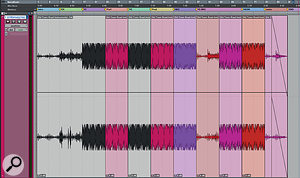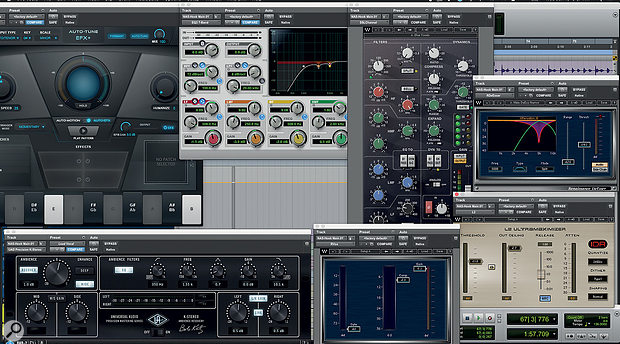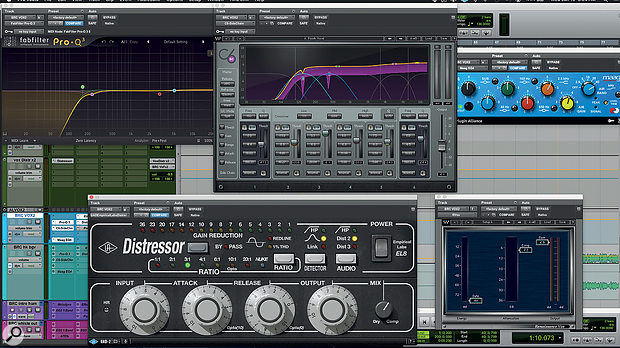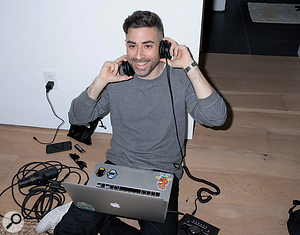Click Comping
Since the release of 'Old Town Road' by Lil Nas X featuring Billy Ray Cyrus (the 'remix' label has been quietly dropped), charts worldwide have been locked in a neck-and-neck race between the two versions. The newer version had the better of it in the US, with its 11 weeks at number one, but the original version reached number two in the UK. Other countries have similarly contradictory stories. A Grammy Award next year surely is a shoo-in.
It's already clear from Bolooki's testimony that the work of a 'VoxGod' involves plenty of time and attention to detail. But what are the details to which he pays so much attention, and how does he fill that time? Bolooki explains his vocal production process, beginning with the microphone. "My favourite microphone is the Telefunken ELA M 251. I don't particularly love using vintage microphones, because I spend a lot of time with the pencil tool having to draw out the anomalies that they put in. If you super zoom in you will hear these weird electrical clicks and pops. However, The Record Plant did not have a 251, so we used one side of an AKG C24, which is stereo, going into a Neve 1073 [preamp and EQ] and then the Tube-Tech CL-1B [compressor]. I engage the 1073 EQ to cut out rumble below 80Hz. For the most part while recording, I ride the 1073 output knob. I record at pretty conservative levels, and will sit there and will manually adjust the level. It helps to get all the takes in line with each other from the get-go. It means I tell people they can't walk by my area in case I need to grab the knob real fast! I record the vocals already in mind with how I comp them. I'll have one vocal track set up in Pro Tools, and literally every single take will go through that. I basically collect all the material via that one track, and then I comp a lead that is just one long WAV file, without doing any doubles or backgrounds. If there are overlapping parts, I might have to put them onto different tracks. But for the most part my first goal is to get one long lead vocal comp.
![Over the course of two vocal sessions with Billy Ray Cyrus, the project ballooned from 16 tracks (above) to 108 (shown below). [Large versions of these screenshots are available to download in the Media sidebar's ZIP file on the right.] Over the course of two vocal sessions with Billy Ray Cyrus, the project ballooned from 16 tracks (above) to 108 (shown below). [Large versions of these screenshots are available to download in the Media sidebar's ZIP file on the right.]](https://dt7v1i9vyp3mf.cloudfront.net/styles/header/s3/imagelibrary/I/IT_08_19_05A-iN.gY0D9gXGGkXAZTCOdp2XgEx3s4zJJ.jpg) Over the course of two vocal sessions with Billy Ray Cyrus, the project ballooned from 16 tracks (above) to 108 (shown below). [Large versions of these screenshots are available to download in the Media sidebar's ZIP file on the right.]
Over the course of two vocal sessions with Billy Ray Cyrus, the project ballooned from 16 tracks (above) to 108 (shown below). [Large versions of these screenshots are available to download in the Media sidebar's ZIP file on the right.]  "I comp with only a click track, and sometimes I'll put a low-pass filter on the beat, playing at very low volume, so you only hear the bass in the background. I'll have very little or no Auto‑Tune on the vocals, because it's easier to comp without Auto‑Tune, and zero effects. The vocal will be entirely dry, apart from that I'll add a ton of compression, to bring up all the room and microphone noises. When you comp with the high end only coming from the vocals, you select takes not only on performance, but also on tone, particularly if they're bright. The brighter ones tend to have the best emotion, too. They may not be in time or in tune, but those things are fixable. I'll also do a lot of clip gaining when comping. When you comp in this way, by the time you're done, it's perfect. If you make the vocal sound good with just a click track, you know you have nailed it. Very little EQ is necessary, and then all you have to do is add some tasteful effects, and your vocal rides, as well as tuning and timing. But you don't have to cover up any of what you did."
"I comp with only a click track, and sometimes I'll put a low-pass filter on the beat, playing at very low volume, so you only hear the bass in the background. I'll have very little or no Auto‑Tune on the vocals, because it's easier to comp without Auto‑Tune, and zero effects. The vocal will be entirely dry, apart from that I'll add a ton of compression, to bring up all the room and microphone noises. When you comp with the high end only coming from the vocals, you select takes not only on performance, but also on tone, particularly if they're bright. The brighter ones tend to have the best emotion, too. They may not be in time or in tune, but those things are fixable. I'll also do a lot of clip gaining when comping. When you comp in this way, by the time you're done, it's perfect. If you make the vocal sound good with just a click track, you know you have nailed it. Very little EQ is necessary, and then all you have to do is add some tasteful effects, and your vocal rides, as well as tuning and timing. But you don't have to cover up any of what you did."
Even towards the very end of his manic stint on 'Old Town Road', Bolooki was still assuming that the track would eventually be mixed by someone else. "Usually when I send my session in, the mixer won't do too much to my vocals. In this case, I figured the label would at least get the separate beat parts from Kio and have the whole song mixed by someone else, but when I asked about it, Wes was like: 'You can't mess with a number one much.' But I still did not think I would actually be submitting the final mix of a massive song, especially since I was working solely off headphones at home towards the very end."
Since YoungKio's original beat remained a stereo stem, Bolooki's work on the Billy Ray Cyrus version of 'Old Town Road' was 95 percent vocal production and vocal mixing, though he changed the arrangement by chopping sections of the original beat out and moving them. In the 108-track large Pro Tools session, YoungKio's instrumental beat is at the top, and, explains Bolooki, the sections in dark grey are in their original place, while he moved all the coloured sections "to help make the record build better overall, since the original version's music was not really arranged by anyone". Tracks 2-4 are a tambourine that was added by Billy Ray Cyrus' wife, Tish, for the final chorus. Tracks 5-14 are Nas X's original vocal and vocal aux tracks, plus seven aux effect tracks (15-21) for Nas' vocal, all from Cinco's session. Bolooki's vocal production session starts with his Master track (22), and below that is his incredibly complex vocal production, consisting of tons of audio, aux bus and effect tracks.
 Although YoungKio's beat remained as a stereo file throughout, Andrew Bolooki chopped it up and reordered it to change the arrangement.Bolooki explains that the enormous size of the session is in part due to the fact that it consists of three sessions rolled into one. "I had my Billy Ray Pro Tools session from March 16th, then another Billy Ray Pro Tools session from March 19th, and then I combined these two, and after I was done with that, the label gave me Nas' original session, and I added that to the main session. That's why there are three groups of audio tracks, each with their own group effects."
Although YoungKio's beat remained as a stereo file throughout, Andrew Bolooki chopped it up and reordered it to change the arrangement.Bolooki explains that the enormous size of the session is in part due to the fact that it consists of three sessions rolled into one. "I had my Billy Ray Pro Tools session from March 16th, then another Billy Ray Pro Tools session from March 19th, and then I combined these two, and after I was done with that, the label gave me Nas' original session, and I added that to the main session. That's why there are three groups of audio tracks, each with their own group effects."
Making Space
Bolooki's 'Old Town Road' session also has an incredibly amount of plug-ins. Most tracks have plug-ins on the inserts, in some cases up to six, and many tracks also have sends to the aux tracks. A complete analysis of exactly what they all do would take up several pages, so Bolooki selected some of the most important processors, starting with Nas X's tracks.
"I did not really mess much with what they sent me. If you listen to the original, there were some Auto‑Tune anomalies, because the plug-in had some notes out of scale. The key of the song is a little weird, so I had to do automation on Nas' Auto‑Tune EFX instances to bypass certain notes in certain passages, to make sure the AT did not warp notes in the wrong way. I also did a lot of vocal riding, nudging the volume of each phrase, so that every single word was crystal-clear, and I did some panning automation in the stacked parts. They wanted Billy and Nas to sing at the same time in the pre-choruses, and I wanted to prevent Billy's harmonies from overwhelming Nas' lead vocals, so I used panning to give them each their own space.
 The plug-in chain for Lil Nas X's vocals was mostly established by Cinco, the engineer who recorded them. Andrew Bolooki discovered that the L2 limiter is a key part of the sound.
The plug-in chain for Lil Nas X's vocals was mostly established by Cinco, the engineer who recorded them. Andrew Bolooki discovered that the L2 limiter is a key part of the sound.
"All Nas X's vocal tracks have an insert effect chain that consists of Antares Auto‑Tune EFX, Avid EQ3 7-band, Waves SSL Channel, Waves Renaissance De-Esser and Waves L2. I made some basic changes, also to some of the delay and reverb sends, but nothing crazy. There's a lazy half-note delay in the intro of the song, that becomes part of the flow of the song, and I did not want to mess with that. The aux track with the AIR Phaser added some modulation in the pre-chorus, and the Waves RVox and UAD Precision K-Stereo made Nas' lead vocal stand out a bit more.
"Also, the original engineer who recorded Nas' vocals did something that I would not normally do, but that made a big difference. I picked it up as a trick. It's having the L2 hit really hard at the end of the effects chain for every single vocal track. Initially I thought: that is pretty extreme to put that on every single vocal track, and it breaks all the rules for gain-staging, so I took it off, but then I realised he had put it there for a saturation effect, and it greatly helped the tone of his vocal. It was part of Nas' sound."
Taking Control
Billy Ray Cyrus' verse lead vocal provides an example of the mind-boggling complexity of Bolooki's vocal treatments. The audio is spread over five tracks (36-40), four of them with the same insert effects chain of Melodyne, FabFilter Pro-Q 3, FabFilter Pro-DS and Waves CLA-76. The fifth track replaces the Pro-DS with the Avid ModDelay 3, and adds a send to the 'rvb2' aux with the Soundtoys Effect Rack. All five audio tracks are routed to an aux group track (35), which has the Pro-Q 3, Waves C6 and RVox, UA Distressor and SSL Channel, plus a whopping seven sends to delay and reverb aux tracks, and another Distressor aux. The quarter- and eighth-note delay auxes themselves each have four insert plug-ins (Waves H-Delay, Pro-Q 3, MetaFlanger, and DVerb) and a send to the 'rvb1' reverb aux. That means that the verse vocal alone has a total of 38 plug-ins, spread over five audio tracks, one group aux track, and seven aux effects tracks!
 Huge numbers of plug-ins were used on Billy Ray Cyrus' vocals: this is the chain on the aux bus through which the lead parts were routed.
Huge numbers of plug-ins were used on Billy Ray Cyrus' vocals: this is the chain on the aux bus through which the lead parts were routed.
Bolooki: "I spoke to a mixer a couple of years ago and asked him how he got things to sound so polished. And he said: 'You can't just throw on a plug-in, you have to take more control, and make sure you purposely put things in different places in different ways.' So, for example, in this song I added the DVerb to the delay auxes, to create a distant effect, so it's not obvious. There are many effects going on, but none of them are overpowering. They are all set back. Nothing gets in the way of the lyrics and the vocal performance. I could probably delete half these effects and it would have sounded the same, but people liked it the way it was, so I left them all.
"This was the first time I used the UAD Distressors and I ended up having two on Billy's vocals: one as part of his main vocal aux, and another set much more aggressively in a parallel and blended back into the same lead vocal aux. This made his vocals really kick ass, and helped make each word crystal-clear. I also ended up copying the Waves SSL strip from Nas' vocals on some of Billy's vocal tracks too, just for some tonal continuity. I have no problem stacking plug-ins on plug-ins. If it's better, it's better.
"Just to highlight some of the other plug-ins I used, there's an aux called 'VoxDoubler' with the Waves Greg Wells VoiceCentric. It definitely adds a bit more of a finished feel and works well mixed in parallel. I put the Waves C6 multiband compressor on almost every single vocal bus, using the 'Pooch Vocal' preset. This cleans up some of the mud. You can solo the side-chain bands and sweep around until you find the annoying frequency, and then just cut that out. If I need to play back something for someone really fast, this is my emergency plug-in to get it to sound better really quickly. Also, the Melodyne plug-in is greyed out, because I printed it. I also like using the Pro-DS, and always put it before the CL76 compressor, because I think it just makes the most sense to fix issues before you boost the whole track with a compressor."
Bolooki explains that he makes frequent use of Celemony's Melodyne as well as Antares' Auto‑Tune. "I usually use both. My process depends on the song. For this song, I actually didn't use Auto‑Tune on Billy's verse at all. I am really proud of how hard he worked in the booth and how little tuning was needed. The Auto‑Tunes I used on some of his chorus tracks are extremely subtle and purposely on slow, automated retune speeds along with automated bypasses so they only kick in exactly when needed with the least amount of correction possible. There was really no stone left unturned when it came to his comps. I spent a ridiculous amount of time tediously combing through all of his takes down to the syllable, so little to no Auto‑Tune was necessary in the end.
"I used Melodyne to keep the timing of his doubled parts together, since they were all recorded separately. I always have Melodyne as the first insert, then basic EQ, de-essing, compression, and then Auto‑Tune if needed. I don't use the stand-alone version of Melodyne anymore, because I like to have Melodyne and Auto‑Tune running into each other at the same time. When I have Auto‑Tune after Melodyne, I tend to not over-tune things, because for me Melodyne is basically just a timing tool. Pitch-wise you have more flexibility with Melodyne than Auto‑Tune, but each has their own strengths. Also, Melodyne purposely does not make things perfect, which I like. When you stack vocals and use Melodyne for adjustments, even corrected vocals will stay somewhat naturally out of tune with each other. So instead I focus mostly on timing in Melodyne, and keep Auto‑Tune on after it, set to a slow retune speed, and I use the Flex-Tune knob quite a bit to allow a lot of humanising."
Done & Dusted
Bolooki's session is maximalist from every perspective, apart from his master bus, which only has the Waves L2 on it. He concludes: "That was purely for listening and sending bounces out. After I finished, I froze all tracks, so the next person would be able to play the session back without having plug-in discrepancies. After I sent it off to Columbia, Joe Grasso handled finalising the session, and Eric Lagg mastered it. When the song was released, I listened to it, and compared it to what I had sent out, and I was surprised to notice that the released version was identical and no mixer was hired. So apparently it's possible to wrap up a number one song on headphones..."
Becoming A VoxGod
 Photo: Jonpaul DouglassGrowing up in Hollywood, Florida, Andrew Bolooki (Instagram handle @voxgod_) got into vocal production via a slightly tortuous route. He played guitar in a band as a teenager, went back to law school for a year, and dropped out again when he met some writers and producers who inspired him to go into music production. In 2010, he got lucky when a beat he co-produced was used for the song 'Round & Round' by Selena Gomez & The Scene. He was advised that he should immediately move to Hollywood, California to capitalise.
Photo: Jonpaul DouglassGrowing up in Hollywood, Florida, Andrew Bolooki (Instagram handle @voxgod_) got into vocal production via a slightly tortuous route. He played guitar in a band as a teenager, went back to law school for a year, and dropped out again when he met some writers and producers who inspired him to go into music production. In 2010, he got lucky when a beat he co-produced was used for the song 'Round & Round' by Selena Gomez & The Scene. He was advised that he should immediately move to Hollywood, California to capitalise.
Several hard years followed, until a successful producer friend named Ammo suggested at the end of 2015 that he become a vocal producer, as there were only a few in LA at the time to work with. Shortly after, Ammo lined Bolooki up to record and do vocal production for a session with Fifth Harmony, which happened to produce 'Work From Home'. The song went five times platinum in the US and two times platinum in the UK. This naturally put VoxGod on the map and he has for nearly four years now been working in the highest echelons of the LA music industry. The perfectionist streak that he displayed when working on 'Old Town Road' clearly runs through his entire way of working, and stands him in good stead in his career.
